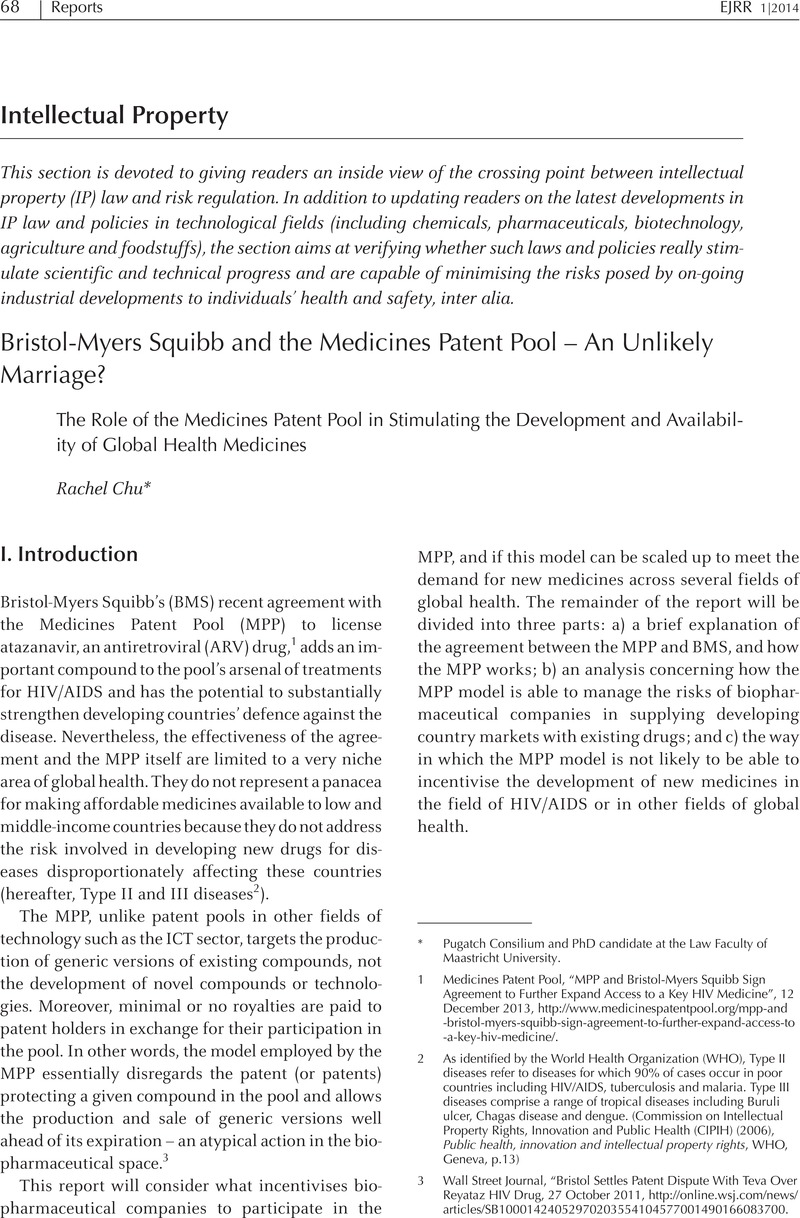No CrossRef data available.
Article contents
Bristol-Myers Squibb and the Medicines Patent Pool – An Unlikely Marriage?
Published online by Cambridge University Press: 20 January 2017
Abstract

- Type
- Reports
- Information
- Copyright
- Copyright © Cambridge University Press 2014
References
1 Medicines Patent Pool, “MPP and Bristol-Myers Squibb Sign Agreement to Further Expand Access to a Key HIV Medicine”, 12 December 2013, http://www.medicinespatentpool.org/mpp-and-bristol-myers-squibb-sign-agreement-to-further-expand-access-to-a-key-hiv-medicine/.
2 As identified by the World Health Organization (WHO), Type II diseases refer to diseases for which 90% of cases occur in poor countries including HIV/AIDS, tuberculosis and malaria. Type III diseases comprise a range of tropical diseases including Buruli ulcer, Chagas disease and dengue. ( Commission on Intellectual Property Rights, Innovation and Public Health (CIPIH) (2006), Public health, innovation and intellectual property rights, WHO, Geneva, p.13 Google Scholar)
3 Wall Street Journal, “Bristol Settles Patent Dispute With Teva Over Reyataz HIV Drug, 27 October 2011, http://online.wsj.com/news/articles/SB10001424052970203554104577001490166083700.
4 World Intellectual Property Organization, Patent Landscape Report on Atazanavir, November 2011, http://www.wipo.int/export/sites/www/freepublications/en/patents/946/wipo_pub_946_2.pdf.
5 Medicines Patent Pool, “MPP and Bristol-Myers Squibb Sign Agreement…”
6 Ibid.
7 Ibid.
8 MPP website, “Licenses in the pool”, http://www.medicinespatentpool.org/licensing/current-licences/.
9 Yadav, P. (2010), Differential Pricing for Pharmaceuticals: Review of current knowledge, new findings and ideas for action, conducted for the UK Department for International Development, August 2010
10 Towse, A. (2013), “Does Price Discrimination Have a Place in Pharmaceutical Pricing in Developing Countries: Examples of Differential Pricing Schemes. Can We Move from Theory to Practice?”, Office of Health Economics, presented at the International Health Economics Association, 9th World Congress, Sydney, 7-10 July 2013, http://www.slideshare.net/OHENews/towse-price-discrimination-ihea-2013-v1.
11 Ibid.
12 Dyer, G., “Netherlands acts against re-sold Aids drugs Africa illegal re-exports uncovered”, The Financial Times, 3 October 2002
13 Alcorn, K. (2007), “Abbott announces Kaletra price cut for lower middle-income countries, makes new offer to Thailand”, AIDS map, 10 April 2007
14 WHO (2012), Draft global vaccine action plan, 65th WHA Provisional agenda item 13.12, p.4
15 BVGH/BIO, Biotechnology: Bringing Innovation to Neglecteed Disease Research and Development, p.5
16 Ibid.
17 WHO (2013), Sustaining the drive to overcome the global impact of neglected tropical diseases: Second WHO report on neglected tropical diseases, p.x; WHO (2012), Draft global vaccine …, p.7; Access to Medicine Foundation (2012), Access to Medicine Index, p.12
18 Ibid.
19 See, for example: DiMasi, J., Hansen, R. & Grabowski, H. (2003) “The Price of Innovation: New Estimates of Drug Development Costs”, Journal of Health Economics, Vol. 22, pp. 151–185 CrossRefGoogle Scholar; and Tufts Center for the Study of Drug Development (2011),“Drug Developers Are Aggressively Changing the Way They Do R&D”, http://csdd.tufts.edu/news/complete_story/pr_outlook_2011; Congressional Budget Office (CBO) (2009), Research and Develompent in the Pharmaceutical Industry, p.21; Frank, R. (2003), “New Estimates of Drug Development Costs”, Journal of Health Economics, Vol.22, No.2, pp.107–142 CrossRefGoogle ScholarPubMed; Paul, S., Mytelka, D., Dunwiddie, C., Persinger, C., Munos, B., Lindborg, S., et al (2010), “How to improve R&D productivity: the pharmaceutical industry's grand challenge”, Nature Reviews Drug Discovery, Vol.9, pp.203–214 Google ScholarPubMed
20 Pedrique, B., Strub-Wourgaft, N., Olliaro, P., Trouiller, P., Ford, N., Some, C., Pecoul, B. & Bradol, J.H. (2013), “The drug and vaccine pipeline for neglected diseases, 2000-2011: a systematic assessment”, Forthcoming publication; Drugs for Neglected Diseases (DNDi) and Medicins Sans Frontieres (MSF) (2012), Medical Innovation for Neglected Patients, p.2 Google Scholar
21 Pugatch, M.P., Chu, R. & Torstensson, D. (2012), Assembling the pharmaceutical R&D puzzle for needs in the developing world: An assessment of new and proposed delinking initiatives aimed at encouraging R&D into neglected and tropical diseases and specific Type II diseases, Commissioned by IFPMA
22 GAVI Alliance, “Pneumococcal AMC”, http://www.gavialliance.org/funding/pneumococcal-amc/


